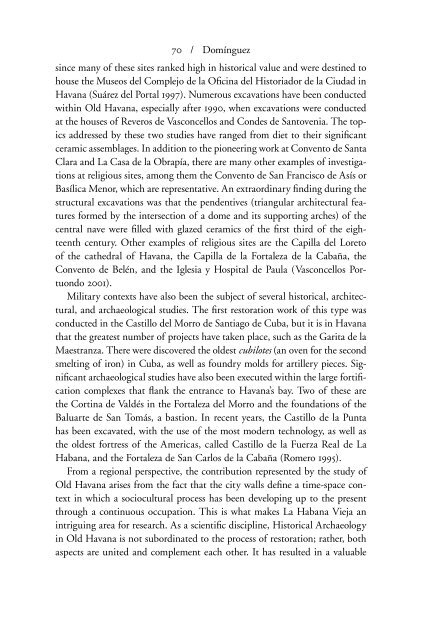Dialogues in Cuban Archaeology
by L. Antonio Curet, Shannon Lee Dawdy, and Gabino La Rosa Corzo
by L. Antonio Curet, Shannon Lee Dawdy, and Gabino La Rosa Corzo
Create successful ePaper yourself
Turn your PDF publications into a flip-book with our unique Google optimized e-Paper software.
70 / Domínguez<br />
s<strong>in</strong>ce many of these sites ranked high <strong>in</strong> historical value and were dest<strong>in</strong>ed to<br />
house the Museos del Complejo de la O¤c<strong>in</strong>a del Historiador de la Ciudad <strong>in</strong><br />
Havana (Suárez del Portal 1997). Numerous excavations have been conducted<br />
with<strong>in</strong> Old Havana, especially after 1990, when excavations were conducted<br />
at the houses of Reveros de Vasconcellos and Condes de Santovenia. The topics<br />
addressed by these two studies have ranged from diet to their signi¤cant<br />
ceramic assemblages. In addition to the pioneer<strong>in</strong>g work at Convento de Santa<br />
Clara and La Casa de la Obrapía, there are many other examples of <strong>in</strong>vestigations<br />
at religious sites, among them the Convento de San Francisco de Asís or<br />
Basílica Menor, which are representative. An extraord<strong>in</strong>ary ¤nd<strong>in</strong>g dur<strong>in</strong>g the<br />
structural excavations was that the pendentives (triangular architectural features<br />
formed by the <strong>in</strong>tersection of a dome and its support<strong>in</strong>g arches) of the<br />
central nave were ¤lled with glazed ceramics of the ¤rst third of the eighteenth<br />
century. Other examples of religious sites are the Capilla del Loreto<br />
of the cathedral of Havana, the Capilla de la Fortaleza de la Cabaña, the<br />
Convento de Belén, and the Iglesia y Hospital de Paula (Vasconcellos Portuondo<br />
2001).<br />
Military contexts have also been the subject of several historical, architectural,<br />
and archaeological studies. The ¤rst restoration work of this type was<br />
conducted <strong>in</strong> the Castillo del Morro de Santiago de Cuba, but it is <strong>in</strong> Havana<br />
that the greatest number of projects have taken place, such as the Garita de la<br />
Maestranza. There were discovered the oldest cubilotes (an oven for the second<br />
smelt<strong>in</strong>g of iron) <strong>in</strong> Cuba, as well as foundry molds for artillery pieces. Signi¤cant<br />
archaeological studies have also been executed with<strong>in</strong> the large forti¤cation<br />
complexes that ®ank the entrance to Havana’s bay. Two of these are<br />
the Cort<strong>in</strong>a de Valdés <strong>in</strong> the Fortaleza del Morro and the foundations of the<br />
Baluarte de San Tomás, a bastion. In recent years, the Castillo de la Punta<br />
has been excavated, with the use of the most modern technology, as well as<br />
the oldest fortress of the Americas, called Castillo de la Fuerza Real de La<br />
Habana, and the Fortaleza de San Carlos de la Cabaña (Romero 1995).<br />
From a regional perspective, the contribution represented by the study of<br />
Old Havana arises from the fact that the city walls de¤ne a time-space context<br />
<strong>in</strong> which a sociocultural process has been develop<strong>in</strong>g up to the present<br />
through a cont<strong>in</strong>uous occupation. This is what makes La Habana Vieja an<br />
<strong>in</strong>trigu<strong>in</strong>g area for research. As a scienti¤c discipl<strong>in</strong>e, Historical <strong>Archaeology</strong><br />
<strong>in</strong> Old Havana is not subord<strong>in</strong>ated to the process of restoration; rather, both<br />
aspects are united and complement each other. It has resulted <strong>in</strong> a valuable


















